| Listing 1 - 9 of 9 |
Sort by
|

ISBN: 1282129465 9786612129469 1400826942 9781400826940 0691124604 9780691124605 9781282129467 6612129468 Year: 2009 Publisher: Princeton, NJ
Abstract | Keywords | Export | Availability | Bookmark
 Loading...
Loading...Choose an application
- Reference Manager
- EndNote
- RefWorks (Direct export to RefWorks)
This book introduces a new class of non-associative algebras related to certain exceptional algebraic groups and their associated buildings. Richard Weiss develops a theory of these "quadrangular algebras" that opens the first purely algebraic approach to the exceptional Moufang quadrangles. These quadrangles include both those that arise as the spherical buildings associated to groups of type E6, E7, and E8 as well as the exotic quadrangles "of type F4" discovered earlier by Weiss. Based on their relationship to exceptional algebraic groups, quadrangular algebras belong in a series together with alternative and Jordan division algebras. Formally, the notion of a quadrangular algebra is derived from the notion of a pseudo-quadratic space (introduced by Jacques Tits in the study of classical groups) over a quaternion division ring. This book contains the complete classification of quadrangular algebras starting from first principles. It also shows how this classification can be made to yield the classification of exceptional Moufang quadrangles as a consequence. The book closes with a chapter on isotopes and the structure group of a quadrangular algebra. Quadrangular Algebras is intended for graduate students of mathematics as well as specialists in buildings, exceptional algebraic groups, and related algebraic structures including Jordan algebras and the algebraic theory of quadratic forms.
Forms, Quadratic. --- Algebra. --- Mathematics --- Mathematical analysis --- Quadratic forms --- Diophantine analysis --- Forms, Binary --- Number theory --- Algebra over a field. --- Algebraic group. --- Associative property. --- Axiom. --- Classical group. --- Clifford algebra. --- Commutator. --- Defective matrix. --- Division algebra. --- Fiber bundle. --- Geometry. --- Isotropic quadratic form. --- Jacques Tits. --- Jordan algebra. --- Moufang. --- Non-associative algebra. --- Polygon. --- Precalculus. --- Projective plane. --- Quadratic form. --- Simple Lie group. --- Subgroup. --- Theorem. --- Vector space.
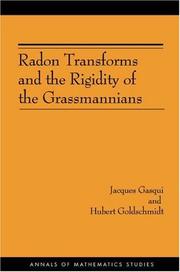
ISBN: 1282158988 9786612158988 1400826179 069111899X 0691118981 9781400826179 9780691118987 9780691118994 Year: 2009 Publisher: Princeton, NJ
Abstract | Keywords | Export | Availability | Bookmark
 Loading...
Loading...Choose an application
- Reference Manager
- EndNote
- RefWorks (Direct export to RefWorks)
This book provides the first unified examination of the relationship between Radon transforms on symmetric spaces of compact type and the infinitesimal versions of two fundamental rigidity problems in Riemannian geometry. Its primary focus is the spectral rigidity problem: Can the metric of a given Riemannian symmetric space of compact type be characterized by means of the spectrum of its Laplacian? It also addresses a question rooted in the Blaschke problem: Is a Riemannian metric on a projective space whose geodesics are all closed and of the same length isometric to the canonical metric? The authors comprehensively treat the results concerning Radon transforms and the infinitesimal versions of these two problems. Their main result implies that most Grassmannians are spectrally rigid to the first order. This is particularly important, for there are still few isospectrality results for positively curved spaces and these are the first such results for symmetric spaces of compact type of rank ›1. The authors exploit the theory of overdetermined partial differential equations and harmonic analysis on symmetric spaces to provide criteria for infinitesimal rigidity that apply to a large class of spaces. A substantial amount of basic material about Riemannian geometry, symmetric spaces, and Radon transforms is included in a clear and elegant presentation that will be useful to researchers and advanced students in differential geometry.
Radon transforms. --- Grassmann manifolds. --- Grassmannians --- Transforms, Radon --- Differential topology --- Manifolds (Mathematics) --- Integral geometry --- Integral transforms --- Adjoint. --- Automorphism. --- Cartan decomposition. --- Cartan subalgebra. --- Casimir element. --- Closed geodesic. --- Cohomology. --- Commutative property. --- Complex manifold. --- Complex number. --- Complex projective plane. --- Complex projective space. --- Complex vector bundle. --- Complexification. --- Computation. --- Constant curvature. --- Coset. --- Covering space. --- Curvature. --- Determinant. --- Diagram (category theory). --- Diffeomorphism. --- Differential form. --- Differential geometry. --- Differential operator. --- Dimension (vector space). --- Dot product. --- Eigenvalues and eigenvectors. --- Einstein manifold. --- Elliptic operator. --- Endomorphism. --- Equivalence class. --- Even and odd functions. --- Exactness. --- Existential quantification. --- G-module. --- Geometry. --- Grassmannian. --- Harmonic analysis. --- Hermitian symmetric space. --- Hodge dual. --- Homogeneous space. --- Identity element. --- Implicit function. --- Injective function. --- Integer. --- Integral. --- Isometry. --- Killing form. --- Killing vector field. --- Lemma (mathematics). --- Lie algebra. --- Lie derivative. --- Line bundle. --- Mathematical induction. --- Morphism. --- Open set. --- Orthogonal complement. --- Orthonormal basis. --- Orthonormality. --- Parity (mathematics). --- Partial differential equation. --- Projection (linear algebra). --- Projective space. --- Quadric. --- Quaternionic projective space. --- Quotient space (topology). --- Radon transform. --- Real number. --- Real projective plane. --- Real projective space. --- Real structure. --- Remainder. --- Restriction (mathematics). --- Riemann curvature tensor. --- Riemann sphere. --- Riemannian manifold. --- Rigidity (mathematics). --- Scalar curvature. --- Second fundamental form. --- Simple Lie group. --- Standard basis. --- Stokes' theorem. --- Subgroup. --- Submanifold. --- Symmetric space. --- Tangent bundle. --- Tangent space. --- Tangent vector. --- Tensor. --- Theorem. --- Topological group. --- Torus. --- Unit vector. --- Unitary group. --- Vector bundle. --- Vector field. --- Vector space. --- X-ray transform. --- Zero of a function.
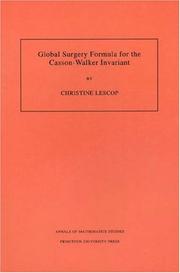
ISBN: 0691021333 1400865158 9781400865154 9780691021331 0691021325 9780691021324 Year: 2014 Volume: 140 Publisher: Princeton, NJ
Abstract | Keywords | Export | Availability | Bookmark
 Loading...
Loading...Choose an application
- Reference Manager
- EndNote
- RefWorks (Direct export to RefWorks)
This book presents a new result in 3-dimensional topology. It is well known that any closed oriented 3-manifold can be obtained by surgery on a framed link in S 3. In Global Surgery Formula for the Casson-Walker Invariant, a function F of framed links in S 3 is described, and it is proven that F consistently defines an invariant, lamda (l), of closed oriented 3-manifolds. l is then expressed in terms of previously known invariants of 3-manifolds. For integral homology spheres, l is the invariant introduced by Casson in 1985, which allowed him to solve old and famous questions in 3-dimensional topology. l becomes simpler as the first Betti number increases. As an explicit function of Alexander polynomials and surgery coefficients of framed links, the function F extends in a natural way to framed links in rational homology spheres. It is proven that F describes the variation of l under any surgery starting from a rational homology sphere. Thus F yields a global surgery formula for the Casson invariant.
Chirurgie (Topologie) --- Drie-menigvuldigheden (Topologie) --- Heelkunde (Topologie) --- Surgery (Topology) --- Three-manifolds (Topology) --- Trois-variétés (Topologie) --- 3-manifolds (Topology) --- Manifolds, Three dimensional (Topology) --- Three-dimensional manifolds (Topology) --- Low-dimensional topology --- Topological manifolds --- Differential topology --- Homotopy equivalences --- Manifolds (Mathematics) --- Topology --- 515.16 --- 515.16 Topology of manifolds --- Topology of manifolds --- 3-manifold. --- Addition. --- Alexander polynomial. --- Ambient isotopy. --- Betti number. --- Casson invariant. --- Change of basis. --- Change of variables. --- Cobordism. --- Coefficient. --- Combination. --- Combinatorics. --- Computation. --- Conjugacy class. --- Connected component (graph theory). --- Connected space. --- Connected sum. --- Cup product. --- Determinant. --- Diagram (category theory). --- Disk (mathematics). --- Empty set. --- Exterior (topology). --- Fiber bundle. --- Fibration. --- Function (mathematics). --- Fundamental group. --- Homeomorphism. --- Homology (mathematics). --- Homology sphere. --- Homotopy sphere. --- Indeterminate (variable). --- Integer. --- Klein bottle. --- Knot theory. --- Manifold. --- Morphism. --- Notation. --- Orientability. --- Permutation. --- Polynomial. --- Prime number. --- Projective plane. --- Scientific notation. --- Seifert surface. --- Sequence. --- Summation. --- Symmetrization. --- Taylor series. --- Theorem. --- Topology. --- Tubular neighborhood. --- Unlink.
Book
ISBN: 1400881250 Year: 2016 Publisher: Princeton, NJ : Princeton University Press,
Abstract | Keywords | Export | Availability | Bookmark
 Loading...
Loading...Choose an application
- Reference Manager
- EndNote
- RefWorks (Direct export to RefWorks)
This book introduces the theory of complex surfaces through a comprehensive look at finite covers of the projective plane branched along line arrangements. Paula Tretkoff emphasizes those finite covers that are free "ients of the complex two-dimensional ball. Tretkoff also includes background on the classical Gauss hypergeometric function of one variable, and a chapter on the Appell two-variable F1 hypergeometric function.The material in this book began as a set of lecture notes, taken by Tretkoff, of a course given by Friedrich Hirzebruch at ETH Zürich in 1996. The lecture notes were then considerably expanded by Hirzebruch and Tretkoff over a number of years. In this book, Tretkoff has expanded those notes even further, still stressing examples offered by finite covers of line arrangements. The book is largely self-contained and foundational material is introduced and explained as needed, but not treated in full detail. References to omitted material are provided for interested readers.Aimed at graduate students and researchers, this is an accessible account of a highly informative area of complex geometry.
Curves, Elliptic. --- Geometry, Algebraic. --- Projective planes. --- Unit ball. --- Riemann surfaces. --- Surfaces, Riemann --- Functions --- Ball, Unit --- Holomorphic functions --- Planes, Projective --- Geometry, Projective --- Algebraic geometry --- Geometry --- Elliptic curves --- Curves, Algebraic --- Appell hypergeometric function. --- Chern numbers. --- Euler number. --- Friedrich Hirzebruch. --- Gauss hypergeometric function. --- Gaussian curvature. --- Hermitian metric. --- Kodaira dimension. --- Mbius transformation. --- Miyaoka-Yau inequality. --- Riemann surface. --- Riemannian metric. --- algebraic geometry. --- algebraic surface. --- arithmetic monodromy group. --- b-space. --- ball "ient. --- canonical divisor class. --- complete quadrilateral. --- complex 2-ball. --- complex manifold. --- complex surface. --- covering group. --- covering space. --- differential geometry. --- divisor class group. --- divisor. --- elliptic curve. --- finite covering. --- first Chern class. --- fractional linear transformation. --- free 2-ball "ient. --- fundamental group. --- geometry. --- intersection point. --- line arrangement. --- line bundle. --- linear arrangement. --- log-canonical divisor. --- minimal surface. --- monodromy group. --- orbifold structure. --- orbifold. --- partial differential equation. --- plurigenus. --- projective plane. --- proportionality deviation. --- ramification indices. --- rational curve. --- regular point. --- signature. --- solution space. --- topological invariant. --- transversely intersecting divisor. --- triangle groups. --- weight.
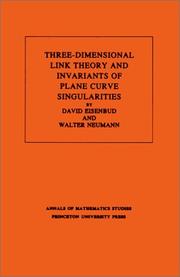
ISBN: 0691083819 0691083800 1400881927 9780691083810 9780691083803 Year: 1985 Volume: 110 Publisher: Princeton Princeton University Press
Abstract | Keywords | Export | Availability | Bookmark
 Loading...
Loading...Choose an application
- Reference Manager
- EndNote
- RefWorks (Direct export to RefWorks)
This book gives a new foundation for the theory of links in 3-space modeled on the modern developmentby Jaco, Shalen, Johannson, Thurston et al. of the theory of 3-manifolds. The basic construction is a method of obtaining any link by "splicing" links of the simplest kinds, namely those whose exteriors are Seifert fibered or hyperbolic. This approach to link theory is particularly attractive since most invariants of links are additive under splicing.Specially distinguished from this viewpoint is the class of links, none of whose splice components is hyperbolic. It includes all links constructed by cabling and connected sums, in particular all links of singularities of complex plane curves. One of the main contributions of this monograph is the calculation of invariants of these classes of links, such as the Alexander polynomials, monodromy, and Seifert forms.
Algebraic geometry --- Differential geometry. Global analysis --- Link theory. --- Curves, Plane. --- SINGULARITIES (Mathematics) --- Curves, Plane --- Invariants --- Link theory --- Singularities (Mathematics) --- Geometry, Algebraic --- Low-dimensional topology --- Piecewise linear topology --- Higher plane curves --- Plane curves --- Invariants. --- 3-sphere. --- Alexander Grothendieck. --- Alexander polynomial. --- Algebraic curve. --- Algebraic equation. --- Algebraic geometry. --- Algebraic surface. --- Algorithm. --- Ambient space. --- Analytic function. --- Approximation. --- Big O notation. --- Call graph. --- Cartesian coordinate system. --- Characteristic polynomial. --- Closed-form expression. --- Cohomology. --- Computation. --- Conjecture. --- Connected sum. --- Contradiction. --- Coprime integers. --- Corollary. --- Curve. --- Cyclic group. --- Determinant. --- Diagram (category theory). --- Diffeomorphism. --- Dimension. --- Disjoint union. --- Eigenvalues and eigenvectors. --- Equation. --- Equivalence class. --- Euler number. --- Existential quantification. --- Exterior (topology). --- Fiber bundle. --- Fibration. --- Foliation. --- Fundamental group. --- Geometry. --- Graph (discrete mathematics). --- Ground field. --- Homeomorphism. --- Homology sphere. --- Identity matrix. --- Integer matrix. --- Intersection form (4-manifold). --- Isolated point. --- Isolated singularity. --- Jordan normal form. --- Knot theory. --- Mathematical induction. --- Monodromy matrix. --- Monodromy. --- N-sphere. --- Natural transformation. --- Newton polygon. --- Newton's method. --- Normal (geometry). --- Notation. --- Pairwise. --- Parametrization. --- Plane curve. --- Polynomial. --- Power series. --- Projective plane. --- Puiseux series. --- Quantity. --- Rational function. --- Resolution of singularities. --- Riemann sphere. --- Riemann surface. --- Root of unity. --- Scientific notation. --- Seifert surface. --- Set (mathematics). --- Sign (mathematics). --- Solid torus. --- Special case. --- Stereographic projection. --- Submanifold. --- Summation. --- Theorem. --- Three-dimensional space (mathematics). --- Topology. --- Torus knot. --- Torus. --- Tubular neighborhood. --- Unit circle. --- Unit vector. --- Unknot. --- Variable (mathematics).
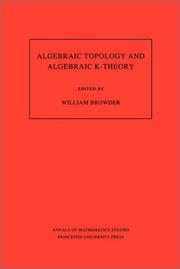
ISBN: 0691084157 0691084262 1400882117 Year: 1987 Publisher: Princeton : Princeton University Press,
Abstract | Keywords | Export | Availability | Bookmark
 Loading...
Loading...Choose an application
- Reference Manager
- EndNote
- RefWorks (Direct export to RefWorks)
This book contains accounts of talks held at a symposium in honorof John C. Moore in October 1983 at Princeton University, The workincludes papers in classical homotopy theory, homological algebra,rational homotopy theory, algebraic K-theory of spaces, and othersubjects.
Algebraic topology --- K-theory --- 512.73 --- 515.14 --- 512.73 Cohomology theory of algebraic varieties and schemes --- Cohomology theory of algebraic varieties and schemes --- 515.14 Algebraic topology --- Moore, John C. --- Abelian group. --- Adams spectral sequence. --- Adjoint functors. --- Adjunction (field theory). --- Algebraic K-theory. --- Algebraic closure. --- Algebraic geometry. --- Algebraic group. --- Algebraic number field. --- Algebraic space. --- Algebraic topology. --- Algebraically closed field. --- Associative algebra. --- Boundary (topology). --- CW complex. --- Classification theorem. --- Closure (mathematics). --- Coalgebra. --- Cofibration. --- Cohomology. --- Commutative diagram. --- Commutative property. --- Coproduct. --- Deformation theory. --- Degenerate bilinear form. --- Diagram (category theory). --- Differentiable manifold. --- Dimension (vector space). --- Division algebra. --- Eilenberg–Moore spectral sequence. --- Epimorphism. --- Exterior (topology). --- Formal power series. --- Free Lie algebra. --- Free algebra. --- Freudenthal suspension theorem. --- Function (mathematics). --- Function space. --- Functor. --- G-module. --- Galois extension. --- Global dimension. --- Group cohomology. --- Group homomorphism. --- H-space. --- Hilbert's Theorem 90. --- Homology (mathematics). --- Homomorphism. --- Homotopy category. --- Homotopy group. --- Homotopy. --- Hopf algebra. --- Hopf invariant. --- Hurewicz theorem. --- Inclusion map. --- Inequality (mathematics). --- Integral domain. --- Isometry. --- Isomorphism class. --- K-theory. --- Lie algebra. --- Lie group. --- Limit (category theory). --- Loop space. --- Mathematician. --- Mathematics. --- Noetherian ring. --- Order topology. --- P-adic number. --- Polynomial ring. --- Polynomial. --- Prime number. --- Principal bundle. --- Principal ideal domain. --- Projective module. --- Projective plane. --- Pullback (category theory). --- Pushout (category theory). --- Ring of integers. --- Series (mathematics). --- Sheaf (mathematics). --- Simplicial category. --- Simplicial complex. --- Simplicial set. --- Special case. --- Spectral sequence. --- Square (algebra). --- Stable homotopy theory. --- Steenrod algebra. --- Superalgebra. --- Theorem. --- Topological K-theory. --- Topological space. --- Topology. --- Triviality (mathematics). --- Uniqueness theorem. --- Universal enveloping algebra. --- Vector bundle. --- Weak equivalence (homotopy theory). --- William Browder (mathematician). --- Géométrie algébrique --- K-théorie
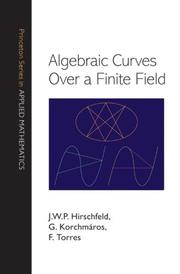
ISBN: 1400847419 9781400847419 1306988608 9781306988605 9781400847426 1400847427 0691096791 9780691096797 9780691096797 Year: 2013 Publisher: Princeton, NJ
Abstract | Keywords | Export | Availability | Bookmark
 Loading...
Loading...Choose an application
- Reference Manager
- EndNote
- RefWorks (Direct export to RefWorks)
This book provides an accessible and self-contained introduction to the theory of algebraic curves over a finite field, a subject that has been of fundamental importance to mathematics for many years and that has essential applications in areas such as finite geometry, number theory, error-correcting codes, and cryptology. Unlike other books, this one emphasizes the algebraic geometry rather than the function field approach to algebraic curves. The authors begin by developing the general theory of curves over any field, highlighting peculiarities occurring for positive characteristic and requiring of the reader only basic knowledge of algebra and geometry. The special properties that a curve over a finite field can have are then discussed. The geometrical theory of linear series is used to find estimates for the number of rational points on a curve, following the theory of Stöhr and Voloch. The approach of Hasse and Weil via zeta functions is explained, and then attention turns to more advanced results: a state-of-the-art introduction to maximal curves over finite fields is provided; a comprehensive account is given of the automorphism group of a curve; and some applications to coding theory and finite geometry are described. The book includes many examples and exercises. It is an indispensable resource for researchers and the ideal textbook for graduate students.
Curves, Algebraic. --- Finite fields (Algebra) --- Modular fields (Algebra) --- Algebra, Abstract --- Algebraic fields --- Galois theory --- Modules (Algebra) --- Algebraic curves --- Algebraic varieties --- Abelian group. --- Abelian variety. --- Affine plane. --- Affine space. --- Affine variety. --- Algebraic closure. --- Algebraic curve. --- Algebraic equation. --- Algebraic extension. --- Algebraic function. --- Algebraic geometry. --- Algebraic integer. --- Algebraic number field. --- Algebraic number theory. --- Algebraic number. --- Algebraic variety. --- Algebraically closed field. --- Applied mathematics. --- Automorphism. --- Birational invariant. --- Characteristic exponent. --- Classification theorem. --- Clifford's theorem. --- Combinatorics. --- Complex number. --- Computation. --- Cyclic group. --- Cyclotomic polynomial. --- Degeneracy (mathematics). --- Degenerate conic. --- Divisor (algebraic geometry). --- Divisor. --- Dual curve. --- Dual space. --- Elliptic curve. --- Equation. --- Fermat curve. --- Finite field. --- Finite geometry. --- Finite group. --- Formal power series. --- Function (mathematics). --- Function field. --- Fundamental theorem. --- Galois extension. --- Galois theory. --- Gauss map. --- General position. --- Generic point. --- Geometry. --- Homogeneous polynomial. --- Hurwitz's theorem. --- Hyperelliptic curve. --- Hyperplane. --- Identity matrix. --- Inequality (mathematics). --- Intersection number (graph theory). --- Intersection number. --- J-invariant. --- Line at infinity. --- Linear algebra. --- Linear map. --- Mathematical induction. --- Mathematics. --- Menelaus' theorem. --- Modular curve. --- Natural number. --- Number theory. --- Parity (mathematics). --- Permutation group. --- Plane curve. --- Point at infinity. --- Polar curve. --- Polygon. --- Polynomial. --- Power series. --- Prime number. --- Projective plane. --- Projective space. --- Quadratic transformation. --- Quadric. --- Resolution of singularities. --- Riemann hypothesis. --- Scalar multiplication. --- Scientific notation. --- Separable extension. --- Separable polynomial. --- Sign (mathematics). --- Singular point of a curve. --- Special case. --- Subgroup. --- Sylow theorems. --- System of linear equations. --- Tangent. --- Theorem. --- Transcendence degree. --- Upper and lower bounds. --- Valuation ring. --- Variable (mathematics). --- Vector space.
Book
ISBN: 1400883857 Year: 2016 Publisher: Princeton, NJ : Princeton University Press,
Abstract | Keywords | Export | Availability | Bookmark
 Loading...
Loading...Choose an application
- Reference Manager
- EndNote
- RefWorks (Direct export to RefWorks)
This famous book was the first treatise on Lie groups in which a modern point of view was adopted systematically, namely, that a continuous group can be regarded as a global object. To develop this idea to its fullest extent, Chevalley incorporated a broad range of topics, such as the covering spaces of topological spaces, analytic manifolds, integration of complete systems of differential equations on a manifold, and the calculus of exterior differential forms. The book opens with a short description of the classical groups: unitary groups, orthogonal groups, symplectic groups, etc. These special groups are then used to illustrate the general properties of Lie groups, which are considered later. The general notion of a Lie group is defined and correlated with the algebraic notion of a Lie algebra; the subgroups, factor groups, and homomorphisms of Lie groups are studied by making use of the Lie algebra. The last chapter is concerned with the theory of compact groups, culminating in Peter-Weyl's theorem on the existence of representations. Given a compact group, it is shown how one can construct algebraically the corresponding Lie group with complex parameters which appears in the form of a certain algebraic variety (associated algebraic group). This construction is intimately related to the proof of the generalization given by Tannaka of Pontrjagin's duality theorem for Abelian groups. The continued importance of Lie groups in mathematics and theoretical physics make this an indispensable volume for researchers in both fields.
Continuous groups. --- Additive group. --- Adjoint representation. --- Algebra over a field. --- Algebraic extension. --- Algebraic variety. --- Algebraically closed field. --- Analytic function. --- Analytic manifold. --- Automorphism. --- Axiom of countability. --- Ball (mathematics). --- Cardinal number. --- Characteristic polynomial. --- Coefficient. --- Commutator subgroup. --- Complex number. --- Connected component (graph theory). --- Continuous function (set theory). --- Continuous function. --- Coordinate system. --- Coset. --- Countable set. --- Covering group. --- Covering space. --- Differential algebra. --- Differential calculus. --- Differential form. --- Differential of a function. --- Dual space. --- Eigenvalues and eigenvectors. --- Endomorphism. --- Equivalence class. --- Existential quantification. --- Exponential function. --- Exterior algebra. --- Fundamental group. --- Galois group. --- General topology. --- Geometry. --- Group (mathematics). --- Group theory. --- Hermitian matrix. --- Homeomorphism. --- Homogeneous space. --- Homomorphism. --- Homotopy group. --- Identity element. --- Identity matrix. --- Infinitesimal transformation. --- Integer. --- Invariant subspace. --- Irreducible representation. --- Kronecker product. --- Lie algebra. --- Lie group. --- Linear function. --- Linear map. --- Linear space (geometry). --- Linear subspace. --- Linearization. --- Locally connected space. --- Manifold. --- Mathematical induction. --- Matrix exponential. --- Modular arithmetic. --- Module (mathematics). --- Monodromy. --- Morphism. --- Open set. --- Orthogonal group. --- Parametric equation. --- Permutation. --- Power series. --- Projective plane. --- Real number. --- Regular matrix. --- Representation theory. --- Riemann surface. --- Simply connected space. --- Skew-symmetric matrix. --- Special case. --- Subalgebra. --- Subgroup. --- Submanifold. --- Subset. --- Summation. --- Symplectic geometry. --- Symplectic group. --- Tangent space. --- Theorem. --- Topological group. --- Topological space. --- Topology. --- Trigonometric polynomial. --- Union (set theory). --- Uniqueness theorem. --- Unitary group. --- Unitary matrix. --- Variable (mathematics). --- Vector space.
Book
ISBN: 1400881803 Year: 2016 Publisher: Princeton, NJ : Princeton University Press,
Abstract | Keywords | Export | Availability | Bookmark
 Loading...
Loading...Choose an application
- Reference Manager
- EndNote
- RefWorks (Direct export to RefWorks)
One of the most cited books in mathematics, John Milnor's exposition of Morse theory has been the most important book on the subject for more than forty years. Morse theory was developed in the 1920s by mathematician Marston Morse. (Morse was on the faculty of the Institute for Advanced Study, and Princeton published his Topological Methods in the Theory of Functions of a Complex Variable in the Annals of Mathematics Studies series in 1947.) One classical application of Morse theory includes the attempt to understand, with only limited information, the large-scale structure of an object. This kind of problem occurs in mathematical physics, dynamic systems, and mechanical engineering. Morse theory has received much attention in the last two decades as a result of a famous paper in which theoretical physicist Edward Witten relates Morse theory to quantum field theory. Milnor was awarded the Fields Medal (the mathematical equivalent of a Nobel Prize) in 1962 for his work in differential topology. He has since received the National Medal of Science (1967) and the Steele Prize from the American Mathematical Society twice (1982 and 2004) in recognition of his explanations of mathematical concepts across a wide range of scienti.c disciplines. The citation reads, "The phrase sublime elegance is rarely associated with mathematical exposition, but it applies to all of Milnor's writings. Reading his books, one is struck with the ease with which the subject is unfolding and it only becomes apparent after re.ection that this ease is the mark of a master.? Milnor has published five books with Princeton University Press.
Homotopy theory. --- Geometry, Differential. --- Affine connection. --- Banach algebra. --- Betti number. --- Bott periodicity theorem. --- Bounded set. --- Calculus of variations. --- Cauchy sequence. --- Characteristic class. --- Clifford algebra. --- Compact space. --- Complex number. --- Conjugate points. --- Coordinate system. --- Corollary. --- Covariant derivative. --- Covering space. --- Critical point (mathematics). --- Curvature. --- Cyclic group. --- Derivative. --- Diagram (category theory). --- Diffeomorphism. --- Differentiable function. --- Differentiable manifold. --- Differential geometry. --- Differential structure. --- Differential topology. --- Dimension (vector space). --- Dirichlet problem. --- Elementary proof. --- Euclidean space. --- Euler characteristic. --- Exact sequence. --- Exponentiation. --- First variation. --- Function (mathematics). --- Fundamental lemma (Langlands program). --- Fundamental theorem. --- General position. --- Geometry. --- Great circle. --- Hessian matrix. --- Hilbert space. --- Homomorphism. --- Homotopy group. --- Homotopy. --- Implicit function theorem. --- Inclusion map. --- Infimum and supremum. --- Jacobi field. --- Lie algebra. --- Lie group. --- Line segment. --- Linear equation. --- Linear map. --- Loop space. --- Manifold. --- Mathematical induction. --- Metric connection. --- Metric space. --- Morse theory. --- N-sphere. --- Order of approximation. --- Orthogonal group. --- Orthogonal transformation. --- Paraboloid. --- Path space. --- Piecewise. --- Projective plane. --- Real number. --- Retract. --- Ricci curvature. --- Riemannian geometry. --- Riemannian manifold. --- Sard's theorem. --- Second fundamental form. --- Sectional curvature. --- Sequence. --- Simply connected space. --- Skew-Hermitian matrix. --- Smoothness. --- Special unitary group. --- Square-integrable function. --- Subgroup. --- Submanifold. --- Subset. --- Symmetric space. --- Tangent space. --- Tangent vector. --- Theorem. --- Topological group. --- Topological space. --- Topology. --- Torus. --- Unit sphere. --- Unit vector. --- Unitary group. --- Vector bundle. --- Vector field. --- Vector space.
| Listing 1 - 9 of 9 |
Sort by
|

 Search
Search Feedback
Feedback About UniCat
About UniCat  Help
Help News
News